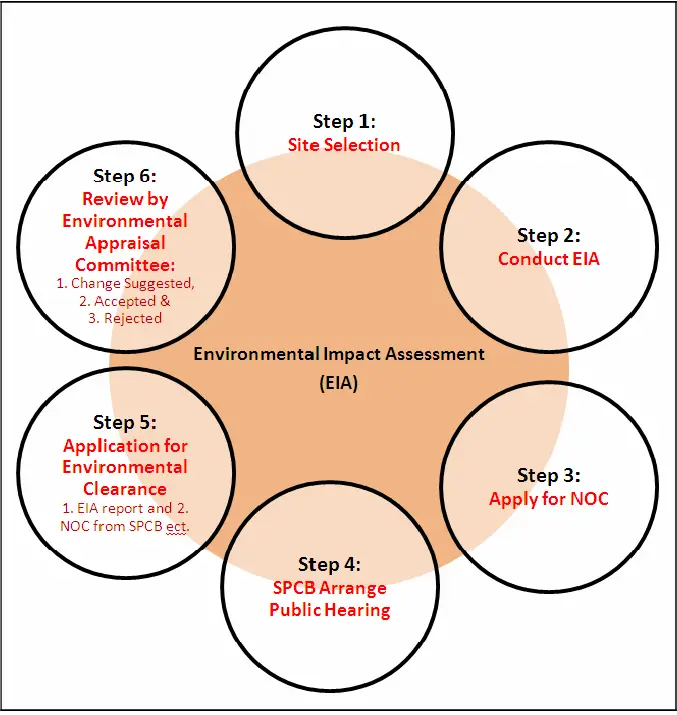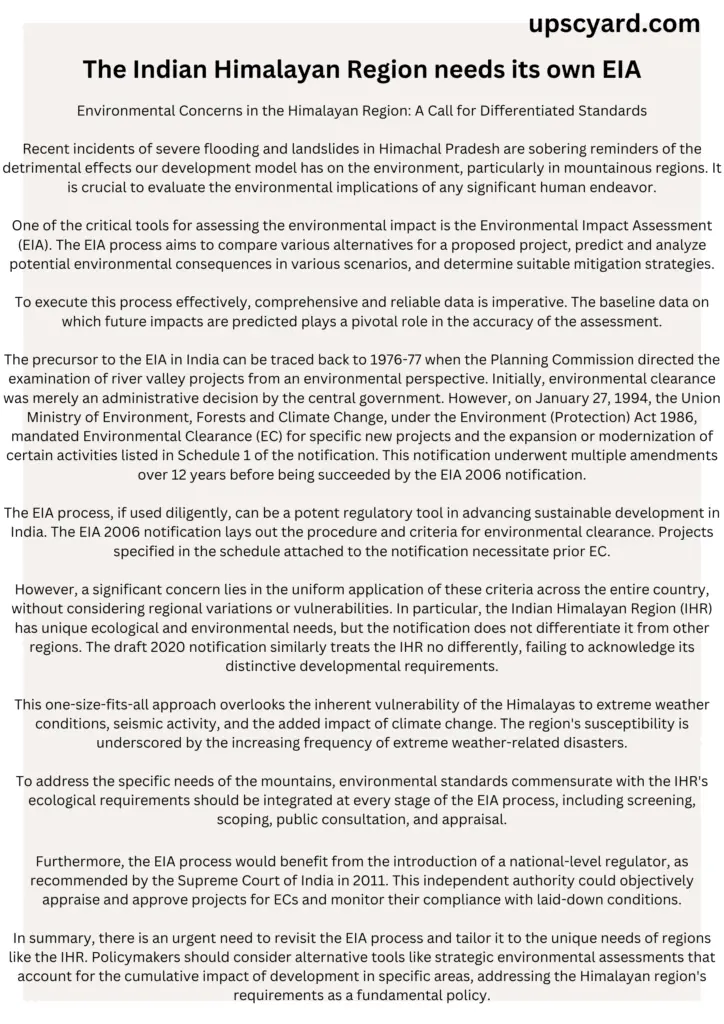Environmental Impact Assessment (EIA) serves as a pivotal process for evaluating the potential environmental consequences of proposed projects or developments. It takes into consideration various socioeconomic, cultural, and human health impacts, encompassing both advantageous and detrimental effects.

UNEP, the United Nations Environment Programme, defines Environmental Impact Assessment (EIA) as a valuable tool used to discern the environmental, social, and economic implications of a project before reaching a decision. The primary objective is to anticipate environmental impacts during the early stages of project planning and design. This entails identifying means to diminish adverse impacts, adapting projects to align with the local environment, and presenting forecasts and choices to decision-makers. EIA, when efficiently employed, can yield both environmental and economic benefits. These advantages encompass cost and time reduction in project implementation and design, avoidance of treatment or cleanup expenses, and compliance with legal regulations and standards.
While regulations and practices in Environmental Impact Assessment (EIA) vary globally, the essential components of Environmental Impact Assessment typically involve the following stages:
- Screening: Identifying which projects or developments require a comprehensive or partial impact assessment study.
- Scoping: Determining relevant potential impacts for assessment, identifying alternative solutions to avoid, mitigate, or compensate for adverse impacts on biodiversity, and defining terms of reference for the impact assessment.
- Assessment and Evaluation: Predicting and identifying potential environmental impacts, including detailed elaboration of alternatives.
- Reporting: Preparing an Environmental Impact Statement (EIS) or EIA report, including an environmental management plan (EMP) and a non-technical summary for the general audience.
- Review: Evaluating the Environmental Impact Statement (EIS) based on terms of reference (scoping) and involving public and authority participation.
- Decision-Making: Deciding whether to approve the project, the conditions under which it will be approved, and whether the project should proceed.
- Monitoring and Compliance: Ensuring that predicted impacts and proposed mitigation measures align with the EMP. Monitoring the proponent’s compliance with the EMP to address unpredicted impacts or failed mitigation measures promptly.

Strategic Environmental Assessment
Sadler and Verheem (1996) define Strategic Environmental Assessment (SEA) as a structured, comprehensive process aimed at identifying and evaluating the environmental repercussions of proposed policies, plans, or programs. SEA’s purpose is to ensure that environmental aspects are thoroughly considered and addressed during the earliest phases of decision-making, on par with economic and social considerations.
Since this initial definition, SEA has rapidly evolved and expanded, leading to a multitude of SEA definitions. SEA encompasses a broader scope of activities or a larger geographical area, often spanning a longer timeframe compared to project-level environmental impact assessments.
SEA can be applied to an entire sector, such as a national energy policy or a specific geographical area, like a regional development scheme. SEA does not replace project-level EIA but enhances the integration of environmental concerns, including biodiversity, into the decision-making process, often making project-level EIA more efficient.
In essence, SEA is characterized as proactive and driven by sustainability goals, while EIA is often seen as a reactive process.
Environmental Impact Assessment (EIA) in India: A Journey of Regulatory Evolution
In India, the framework of Environmental Impact Assessment (EIA) is legally underpinned by the Environment Protection Act of 1986, which encompasses various provisions concerning EIA methodology and procedures. The evolution of EIA in India, with a mix of historical and legislative milestones, has been instrumental in shaping environmental governance in the country. Here’s a brief look at the history and key developments:
The Genesis of EIA in India:
India’s tryst with Environmental Impact Assessment commenced over two decades ago. It had its genesis in 1976-77 when the Planning Commission tasked the Department of Science and Technology with scrutinizing river-valley projects from an environmental perspective. This marked the early recognition of the need to assess and mitigate environmental consequences associated with development projects.
Pre-1994: Administrative Clearance:
Before 1994, the process of securing environmental clearance from the Central Government was primarily an administrative decision and needed strong legislative support. While environmental concerns were acknowledged, regulatory mechanisms still needed to be fully established.
The Transformative EIA Notification of 1994:
A significant turning point occurred on 27 January 1994 when the Union Ministry of Environment and Forests, empowered by the Environmental (Protection) Act of 1986, issued an EIA notification. This notification mandated the acquisition of Environmental Clearance (EC) for the expansion, modernization, or establishment of new projects listed in Schedule 1 of the notification. It signified a pivotal shift towards a more structured and regulated approach to EIA in India.
EIA Legislation of 2006: A Decentralized Approach:
The Ministry of Environment, Forests and Climate Change (MoEFCC) introduced new EIA legislation in September 2006. The notification expanded the ambit of projects requiring environmental clearance. This included sectors like mining, thermal power plants, river valley projects, infrastructure development (such as roads, highways, ports, harbours, and airports), and industries, encompassing even very small electroplating or foundry units.
However, a notable feature of the 2006 legislation was the decentralization of the clearance process. The responsibility for granting clearance was now placed with state governments, contingent on the size and capacity of the project. This shift aimed to streamline the process and facilitate a more tailored approach to EIA based on the specific context and scale of each project.
In essence, the history of EIA in India reflects the nation’s growing recognition of the need for robust environmental governance. From its early stages of river-valley project assessments to the comprehensive legislative framework of 2006, India’s journey with EIA has been a crucial element in achieving sustainable development while safeguarding the environment.
EIA Notification 2006: A Decisive Step in Environmental Oversight
The Environmental Impact Assessment (EIA) Notification of 2006 marked a significant milestone in India’s approach to environmental governance. This pivotal notification introduced several key changes to the Environmental Impact Assessment process, expanding its scope and enhancing the oversight of developmental projects’ environmental impacts. Here are some critical aspects of this important notification:
1. Decentralization of Project Clearances: One of the central features of the 2006 notification was the classification of developmental projects into two categories:
- Category A (National Level Appraisal): Projects falling under this category are subject to appraisal by the Impact Assessment Agency (IAA) and the Expert Appraisal Committee (EAC) at the national level.
- Category B (State Level Appraisal): For projects classified under Category B, the responsibility for clearance shifted to the State Level Environment Impact Assessment Authority (SEIAA) and the State Level Expert Appraisal Committee (SEAC) at the state level.
2. Introduction of Different Stages: The amendment introduced a structured framework consisting of four stages within the EIA cycle. These stages are:
- Screening
- Scoping
- Public Hearing
- Appraisal
- Category A projects are mandated to obtain environmental clearance, exempting them from the screening process.
- Category B projects, however, undergo a screening process, with further categorization into B1 (projects mandatorily requiring EIA) and B2 (projects not necessitating EIA).
- Projects with Mandatory Clearance: The 2006 EIA Notification specifically identified a range of projects that must obtain environmental clearance. These include:
- Mining projects
- Thermal power plants
- River valley projects
- Infrastructure development projects like roads, highways, ports, harbours, and airports
- Various industries, including very small electroplating or foundry units
This comprehensive framework expanded the reach of environmental oversight and established a systematic approach to assessing and regulating projects with potential environmental impacts. It allowed for better differentiation between projects based on their potential for environmental repercussions and ensured that the appropriate level of scrutiny and clearance was applied to each project. The Environmental Impact Assessment (EIA) Notification 2006 is a significant pillar in India’s environmental regulatory framework, helping strike a balance between development and environmental conservation.
GOI Amendment 2009
Assessing Sand and Dust Storm Risks in Asia and the Pacific
The comprehensive Report titled “Sand and Dust Storms Risk Assessment in Asia and the Pacific” has been released by the Asian and Pacific Centre for the Development of Disaster Information Management (APDIM), with support from the Economic and Social Commission for Asia and the Pacific (ESCAP). This ground breaking study marks the initial endeavour to evaluate and dissect the threats posed by sand and dust storms across an expansive geographical area.
Key Insights from the Report:
- A Vast Population at Risk: India is grappling with the consequences of sand and dust storms, with more than 500 million people exposed to medium and high levels of poor air quality due to these phenomena.
- Prominent Sand and Dust Storm Corridors: The Asia-Pacific region stands as the world’s second-largest emitter of mineral dust, encompassing four primary sand and dust storm corridors, notably East and North-East Asia, South and South-West Asia, Central Asia, and the Pacific subregions.
- Undermining Sustainable Development Goals: Sand and dust storms emerge as direct threats to the achievement of 11 out of the 17 Sustainable Development Goals.
- Widespread Air Quality Concerns: Countries like Turkmenistan, Pakistan, Uzbekistan, Tajikistan, and Iran witness more than 80 per cent of their populations exposed to medium and high levels of poor air quality due to these storms.
Impact on Various Sectors:
- Energy Generation: The presence of sand and dust storms adversely impacts the electricity generation from solar power plants. Economically, the effects are substantial, surpassing USD 107 million per year in India and exceeding USD 46 million and USD 37 million annually in China and Pakistan, respectively.
- Aviation Sector: Dust particles pose significant risks to aircraft engines on flight paths over southwestern and central Asia, especially affecting regions in the Arabian Peninsula, Pakistan, India, and China.
- Agriculture: Vast cropland areas in Turkmenistan (71%), Pakistan (49%), and Uzbekistan (44%) are impacted by dust deposition. The high salt content in the sand and dust jeopardizes crop yields, particularly affecting irrigated cotton production and other crops.
- Mountain Ecosystems: The Himalaya-Hindu Kush Mountain range and the Tibetan Plateau, which provide freshwater to over 1.3 billion people in Asia, face substantial dust deposition. This, in turn, leads to a warming effect, accelerating glacier melting with cascading effects on food security, energy production, agriculture, water resources, and flood patterns.
- Urban Areas: Cities in southwestern Asia experience a significant impact on air quality. Karachi, Lahore, and Delhi, inhabited by nearly 60 million people, contend with over 170 dusty days annually, contributing to deteriorating air quality.
Anticipated Risks:
The Report anticipates that the risks associated with sand and dust storms will escalate in the 2030s, primarily due to more severe drought conditions in regions of Western Australia, south-eastern Turkey, the Islamic Republic of Iran, and Afghanistan. Conversely, areas like Kazakhstan, northern China, Mongolia, and the Ganges basin in India face lower drought risk and thus are likely to experience fewer impacts from these storms.
Importantly, the Report highlights the multifaceted nature of dust storms. While often viewed negatively, dust particles can transport iron, enriching oceanic regions, rebalancing phytoplankton, and positively affecting marine food chains.
About the Economic and Social Commission for Asia and the Pacific (ESCAP):
ESCAP, as one of the five regional commissions of the United Nations, stands as the most inclusive intergovernmental platform in the Asia-Pacific region. With 53 member States and 9 associate members, ESCAP is committed to fostering collaboration and devising sustainable solutions to development challenges. Its primary objective revolves around promoting comprehensive and sustainable economic and social development in the Asia-Pacific region, with a strong emphasis on advancing the 2030 Agenda for Sustainable Development and achieving the Sustainable Development Goals.
F.A.Q.
Q. What is Environmental Impact Assessment ?
Answer :- Environmental Impact Assessment (EIA) as a valuable tool used to discern the environmental, social, and economic implications of a project before reaching a decision.
M.C.Q
Q. With reference to ‘Environmental Impact Assessment(EIA)’, consider the following statements:
1. EIA predicts environmental impacts at an early stage of project planning.
2. It is statutorily backed by the Environment Protection Act, 1986
A) 1 Only
B) 2 Only
C) Both 1 & 2
D) Neither 1 & 2
Answer :- C
